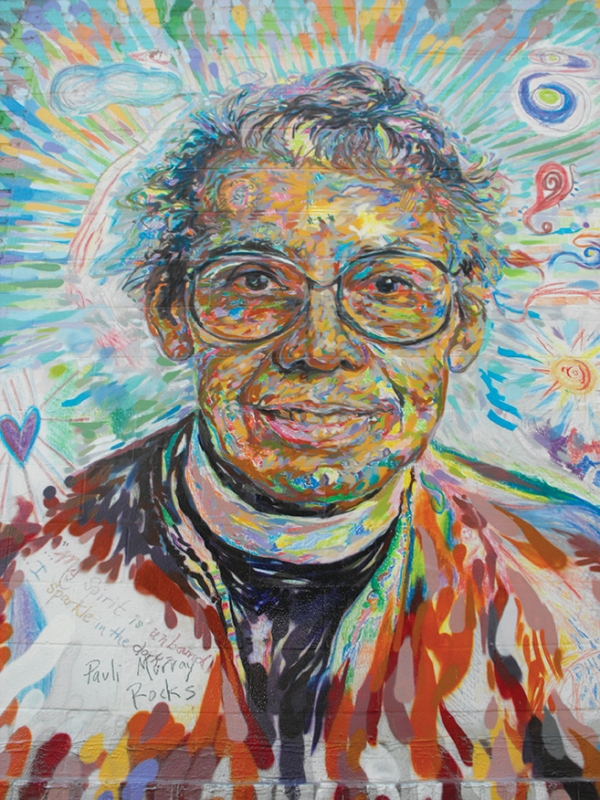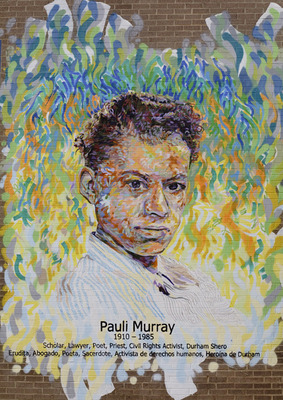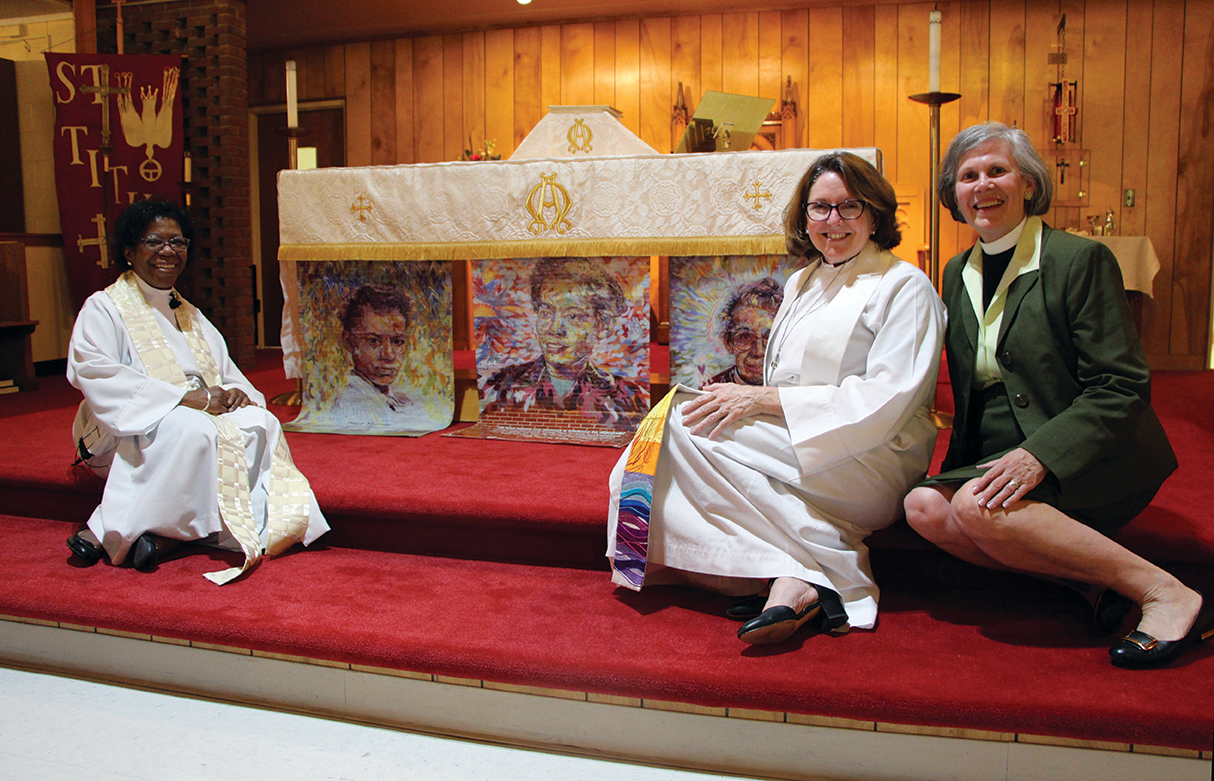Pauli Murray

Durham native the Rev. Pauli Murray was the first Black person perceived as a woman ordained to the Episcopal priesthood. In 2012, they were named to Holy Women, Holy Men by the 77th General Convention of the Episcopal Church and thus became an Episcopal saint. According to their entry, "Growing up as a mixed-race person in the South, [Murray] became an advocate of ‘the universal cause of freedom,’ and throughout her life she worked tirelessly and with distinction as a lawyer, an advocate for civil and labor rights and feminism through her legal writings, essays and poetry.” Today, as we continue to learn more about Murray from their writings, we would add to their list of accomplishments LGBTQ+ advocate. (Curious about the pronouns used to describe Pauli Murray? Read more about it from the Pauli Murray Center.)
BIOGRAPHICAL TIMELINE
*The compilation of this timelime is an ongoing project.
1854: Pauli’s maternal grandmother, Cornelia Smith, was the daughter of an enslaved person (Harriet) and a slave owner (Sidney Smith). Cornelia grew up on the Smith plantation on Smith Level Road in Chapel Hill, where she was raised by Mary Ruffin Smith, sister of Sidney; Mary was therefore both her aunt and her owner. Cornelia was brought to services at The Chapel of the Cross by Mary and sat in the slave balcony. Cornelia was baptized December 20, 1854 at The Chapel of the Cross, as “one of the five servant children belonging to Miss Mary Ruffin Smith,” according to the parish register.
Pauli’s maternal grandfather, Robert Fitzgerald, (whose father was a freed formerly enslaved person and whose mother was white) came south as a schoolteacher during Reconstruction. The family worshiped at St. Matthew’s Episcopal Church in Hillsborough, NC, where their children were baptized. They later moved to Durham, where Robert and his brothers established a thriving brick business and lived in a house on Kent Street.
According to the typewritten Origins of St. Titus Episcopal Church (Durham, NC), “St. Philip’s Episcopal Church…reported in May 1889 that there were 127 communicants – 121 white and 6 black. Some of the earliest colored communicants were Cornelia Smith Fitzgerald and several of her daughters who had attended St. Augustine’s School. By the 1890’s, however, there was increasing sentiment among white Episcopalians in southern Diocese for separate churches.” Later in that document is a note from Pauli Murray: “My family tradition is that my aunts, Mrs. Pauline Fitzgerald Dame and Miss Sarah A. Fitzgerald (who later married the Rev. J. E. G. Small) were among the prime movers to establish St. Titus Mission. They were products of St. Augustine’s School and longtime friends of the Rev. Henry Beard Delany, Archdeacon in charge of work among colored members of the Episcopal Diocese of North Carolina.”
November 20,1910: Anna Pauline Murray born at home: 1330 Argyle Avenue, Baltimore, Maryland.
July 9, 1911: Baptized by the Rev. George F. Bragg at St. James’ Episcopal Church, Baltimore, Maryland.
1913: Moved to Durham after their mother died. Raised by maternal grandparents, Cornelia Smith Fitzgerald and Robert Fitzgerald, and mother’s sister, Pauline (an elementary school teacher for whom Pauli was named). Lived in house at what is now 906 Carroll Street. (House has been purchased by the Pauli Murray Project, which is renovating it for use as a center for dialogue, learning and the arts, as well as a national monument and memorial to Murray’s groundbreaking life.)
The Fitzgerald family graveyard is behind the house. For many years, the family plot was separated by an iron picket fence from the adjacent Maplewood Cemetery, which was limited to whites; in the late 1990s, the fence was taken down and the Fitzgerald plots are now part of the city-maintained cemetery.
Worshiped at St. Titus’ Episcopal Church in Durham.
Age 9: Confirmed by the Right Reverend Henry B. Delany, Suffragan Bishop for Colored Work in North Carolina.
1928: Visited Bishop Delany on his deathbed. According to Murray’s autobiography, “During his prayers he blessed me, and later he said to me, ‘You are a child of destiny’.” (p. 70)
Attended the West End School and graduated from Hillside High School, both in Durham.
1928 - ?: Worshiped at All Saints Episcopal Church, Brooklyn, NY, where they sang in the choir.
 1940: Joined the Fellowship of Reconciliation, a Christian social justice organization
1940: Joined the Fellowship of Reconciliation, a Christian social justice organization
? – 1944: Worshiped at the Church of the Atonement, Washington, DC. Vicar was the Rev. Eugene L. Henderson, who had been the vicar at St. Titus’ in Durham. (In their autobiography, Pauli comments, “No one could have conceived…that thirty-five years later I would be serving in the same church as an Episcopal priest.” [p. 245])
1948 – 1951: Worshiped on weekdays at Saint Paul’s Chapel, New York, NY
1955: Pauli’s Aunt Pauline died. Pauli read to her on her deathbed from The Book of Common Prayer. Pauli’s autobiography states, “Yet for a long time after her death I felt an incompleteness, as if I had somehow failed her, and I kept asking myself why, in the ultimate crisis of a devout Christian life, I was called upon to render the service that I then believed was authentic only when performed by an ordained member of the clergy. I would wrestle with that question over and over before finding an answer.” (p. 304)
1966: Moved back to New York City and resumed worshiping at St. Mark’s Church-in-the-Bowery, to which they and Renee Barlow had belonged since “before I went to Africa” (which was 1960). Sang in the choir.
March 1966: Walked out of St. Mark’s in the middle of the Sunday service because they could no longer tolerate the sight of only boys and men filling all the roles except choir member. “The intensity of this assault at the deepest level of my devotional life produced a crisis in faith,” they wrote. (autobiography, p. 370)
February 21, 1973: Their partner, Irene "Renee" Barlow, died. Again, Pauli was at her bedside and read the 23rd Psalm. Pauli planned the memorial service, which was held February 27 at Calvary Episcopal Church, New York City. The Rev. Thomas F. Pike officiated at the service; afterwards, he commended Pauli on the beautiful service and asked them if they’d ever thought about being ordained.
? – 1973: Worshiped at Emmanuel Church, Boston. Consulted with the Rev. Alvin L. Kershaw at Emmanuel regarding a possible call to ordination. “Once I admitted the call of total commitment to service in the church, it seemed that I had been pointed in this direction all my life and that my experiences were merely preparation for this calling. In spite of my own intellectual doubts and the opposition to women’s ordination which was widespread within the Episcopal Church at the time, I took the fateful step of applying to the Right Reverend John M. Burgess, bishop of the Diocese of Massachusetts, for admission to holy orders.” (Autobiography, p. 427)
1973: Entered General Theological Seminary.
Considered Emmanuel Church, Boston to be “my home parish church” and “my sponsoring parish,” which “sent me forth as a member of your congregation with your blessings and prayers to begin my training for the Sacred Ministry.” (Quotation from a sermon preached at Emmanuel Church, March 3, 1974)
July 29, 1974: Attended the “irregular” ordination of 11 women priests at the Church of the Advocate in Philadelphia, PA.
June 15, 1975 (Sermon preached at St. Philip’s Church, New York City; sermon book, p. 12-17): “My return to St. Philip’s this morning as a candidate for Holy Orders in Christ’s Holy Catholic Church, after an absence of many years, is somewhat like the homecoming of a prodigal. For it was here at St. Philip’s that I had my first spiritual crisis…. My first assignment … was to teach a Sunday school class of twelve-year-old boys, and the theme for the church year was the life of Jesus Christ…. After about two lessons with those squirming youngsters, I experienced perhaps my first defeat in performance…. The realization that what I had taken for granted all of my life could not be communicated to others was a traumatic experience…. And so a crisis in teaching became a crisis of faith. … I resigned from teaching the Sunday school class, eventually dropped out of church for several years, and began a lifelong quest for the meaning of Jesus Christ in my life.”
1975 – 1976: Spent third year of seminary at Virginia Theological Seminary. Served as seminarian at St. Philip’s Chapel, Aquasco, Maryland (the church that their uncle, the Rev. Small, had served 50 years previously, after leaving St. Titus’ in Durham). In a sermon preached at St. Philip’s on September 21, 1975 (sermon book, pp. 109-113), Pauli said, “This is also a homecoming for me. Most of you have heard of my early connections with this church. When I was ten years old, I came to live in Croom with my uncle and aunt, the late Rev. and Mrs. John Small, when my uncle became vicar of St. Simon’s in Croom, St. Philip’s here, and St. Mary’s in Charlotte Hall. During the crucial years of growing into adulthood, I spent my summers and holidays here, and these three churches were extensions of my home.”
January 31, 1976: Sermon preached on the ordination of women, as part of their ordination examinations (sermon book, pp. 58-63).
1976 (age 65): Received Master of Divinity degree. Ordained a deacon in The Episcopal Church by the Rt. Rev. Morris F. Arnold, Suffragan Bishop of Massachusetts.
1976: The Episcopal Church, at its General Convention, voted to ordain women as priests, beginning January 1, 1977.
January 8, 1977: Ordained a priest in The Episcopal Church at the Washington National Cathedral by the Rt. Rev. William F. Creighton, bishop of the Diocese of Washington. The first African American person perceived as a woman to be ordained a priest in The Episcopal Church, and one of the first people perceived as a woman to be ordained a priest.
February 13, 1977: Celebrated their first Eucharist at the Chapel of the Cross, at the invitation of the rector, the Rev. James Peter Lee. Read from the Bible that had belonged to their grandmother (Cornelia Smith), from a lectern that had been given in memory of the woman who owned Cornelia (Mary Ruffin Smith). This was also the first time a person perceived as a woman celebrated the Eucharist at an Episcopal church in North Carolina.
In their autobiography (p. 435), Pauli described their feelings at the Chapel of the Cross service as follows: “Whatever future ministry I might have as a priest, it was given to me that day to be a symbol of healing. All the strands of my life had come together. Descendant of slave and of slave owner, I had already been called poet, lawyer, teacher, and friend. Now I was empowered to minister the sacrament of One in whom there is no north or south, no black or white, no male or female – only the spirit of love and reconciliation drawing us all toward the goal of human wholeness.”
May 14, 1978 (Sermon preached at St. Philip’s Episcopal Church, Durham, NC; sermon book, pp. 88-94.) “It is entirely appropriate that my first sermon and celebration as a priest in Christ’s one, holy, catholic, and apostolic church in my ‘hometown’ where I grew up be performed on Mother’s Day in the Church of St. Philip’s. For it was this church that my grandmother, my aunts, and my mother attended before I was born…. I feel moved to share with you some reflections upon women I have known who had the gift of the Holy Spirit and whose impact on my life brings me to you today in a unique homecoming. The first was my grandmother, Cornelia Smith Fitzgerald, a citizen of Durham until her death in 1923. A devout Episcopalian, she sent three of her daughters, one of whom was my mother, to St. Augustine’s School in Raleigh, and they in turn were confirmed and attended St. Philip’s…. The contribution I hope to make as one of the successors to Martin Luther King, Jr. is to address myself to the possibility of reconciliation.”
1977 (or 1979?) – 1981 (or 1982?): Served as a priest at the Church of the Atonement, Washington, DC
1982 – ?: Assisted at home church, the Church of the Holy Nativity, Baltimore, MD
July 1, 1985: Died of cancer in Pittsburgh, PA. Memorial service held July 5, 1985 in the Washington National Cathedral.
February 2007: Presiding Bishop Katharine Jefferts Schori celebrated the Eucharist and preached at The Chapel of the Cross, in commemoration of the 30th anniversary of Pauli’s ordination. In her sermon, Bishop Katharine said, “I know I stand here today only because she [Pauli] stood here before me. Her proud shoes carried many others down the road to freedom. ”
 2009 – 2012 (and continuing): Annual commemorations of the life and work of Pauli Murray at St. Titus’ Episcopal Church, Durham.
2009 – 2012 (and continuing): Annual commemorations of the life and work of Pauli Murray at St. Titus’ Episcopal Church, Durham.
2011: Publication of book by Azaransky analyzing Pauli’s writings. “Ranging from Murray’s theologically rich democratic criticism of the 1930s to her democratically inflected sermons of the 1980s, this study proclaims Murray to be a significant twentieth-century African American intellectual who grounded her calls for democratic transformation in Christian concepts of reconciliation and of the coming kingdom.” (p. 3) “…Murray’s preeminent theological concern – reconciliation… between human beings and between human beings and God. For Murray, reconciliation is intimately connectd with salvation…. Murray worried that despite clear teaching to the contrary, many people assume tha their religious faith offers private salvation, because many Christians do not understand the second great commandment with the same urgency as the first.” (p. 112) “For Murray, salvation entailed the power and possibility of transforming the world and of restoring creation.” (p. 114)
General Convention 2012: Added to the Calendar of Commemorations of The Episcopal Church, and thus to Holy Women, Holy Men (trial use for the triennium 2012-2015; Resolution A052). Explanation statement:
“Pauli Murray (July 1): Pauli Murray (1910 – July 5, 1985) was the first African-American woman ordained to the Episcopal priesthood (1977). Growing up as a mixed-race person in the South, she became an advocate of ‘the universal cause of freedom,’ and throughout her life she worked tirelessly and with distinction as a lawyer, an advocate for civil and labor rights and feminism through her legal writings, essays and poetry.”
SELECTED BIBLIOGRAPHY
Azarahsky, Sara. The Dream is Freedom: Pauli Murray and American Democratic Faith. New York: Oxford University Press, 2011.
Kujawa-Holbook, Sheryl A. Anna Pauline “Pauli” Murray (1911 – 1985). Pp. 272-279. In: Freedom Is a Dream: A Documentary History of Women in The Episcopal Church. Church Publishing Inc., New York, NY. 2002.
Murray, Pauli. Proud Shoes: The Story of an American Family. Originally published by Harper (New York), 1956. Reprinted by Harper & Row (New York), 1978. Reprinted again by Beacon Press (Boston), 1999
Murray, Pauli. Song in a Weary Throat: An American Pilgrimage. New York: Harper & Row, 1987. Reissued as Pauli Murray: The Autobiography of a Black Activist, Feminist, Lawyer, Priest and Poet. University of Tennessee Press, 1989.
Pinn, Anthony B, ed. Pauli Murray: Selected Sermons and Writings. Maryknoll NY: Orbis Books, 2006.
PAULI MURRAY RESOURCES
Learn more about Pauli Murray through the Pauli Murray Project.
Watch Bishop Curry’s reflection on Pauli Murray.
Listen to a collection of local stories about Pauli Murray from WUNC.
Read what the rest of the country learned about Pauli Murray from The Huffington Post.
Read Meg McCann's reflection on Pauli Murray during the 2012 Diocese of North Carolina ECW Annual Meeting.
